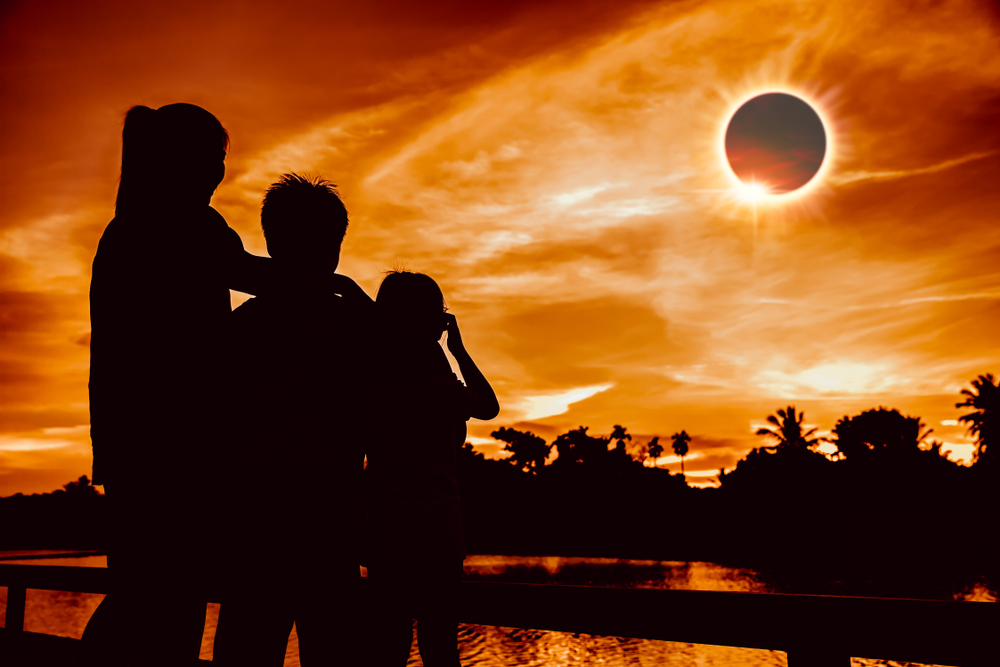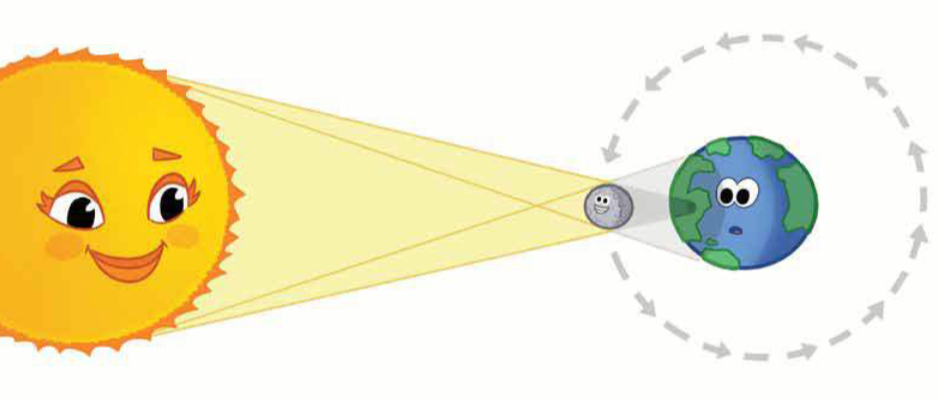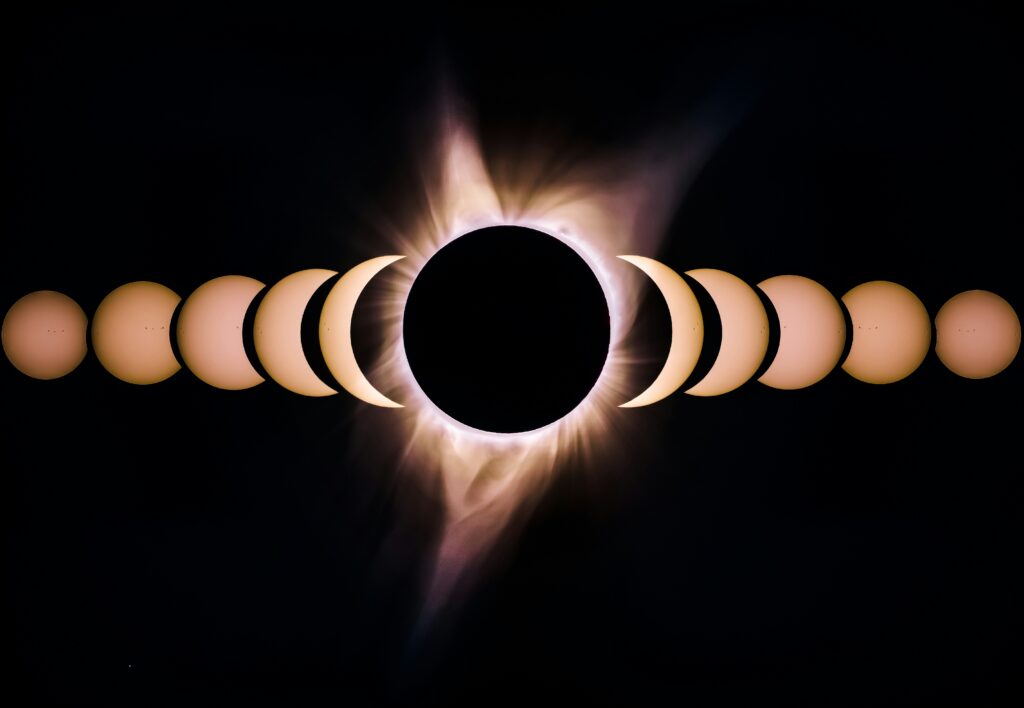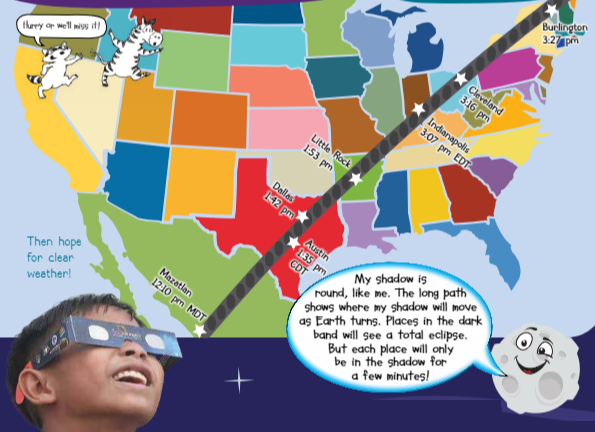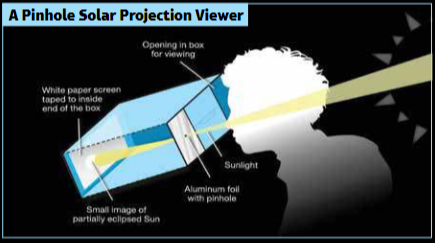The Great American Eclipse is sweeping the nation on Monday, April 8! For many Americans, it’s a true once-in-a-lifetime experience. But how can you prepare for this astronomical phenomenon, and how on earth can you explain it to your kids? We’re here to answer all of your eclipse-related questions! The March issues of four of our award-winning children’s magazines (ASK, CLICK, MUSE, and COBBLESTONE) are all packed with fascinating info about eclipses past, present, and future, and we can’t wait to share it with you!

So what exactly is an eclipse, anyway?
A total solar eclipse (the kind we’ll be expecting on April 8) occurs when the moon passes between the earth and sun, completely blocking out the sun. In reality, the sun is 400 times bigger than the moon, too big to be covered up. But it’s also 400 times further away. This means the sun and the moon look the same size from earth, causing a neat optical illusion!
The moon actually passes the sun once per month in its regular orbit, but because the moon orbits at a bit of a tilted angle, it usually moves slightly above or below the sun, not close enough to block it out. It’s only when their paths perfectly align that a total solar eclipse occurs.
There are other types of eclipses, too. A partial solar eclipse happens when the moon passes between the earth and the sun, but they’re not all perfectly aligned. The sun will turn into a crescent shape instead of totally disappearing. There’s also something called an annular solar eclipse. This is like a total solar eclipse, but with one difference. While the moon is aligned with the sun, it’s further away from earth in its orbit, causing it to look smaller than the sun. Instead of blocking the whole sun, it turns the sun into a donut shape with a hole in the middle. When the earth itself casts a shadow on the full moon, that’s called a lunar eclipse. When this happens, the moon will turn a startling shade of red!

How do scientists know a solar eclipse is coming?
Ever since ancient times, scientists from different cultures have watched the skies, checked records, and noticed patterns. Some tracked orbits to predict when the sun, moon, and earth would all align. Others kept careful track of dates on calendars. Over 2,000 years ago, Chaldean astronomers noticed that the sun, moon, and earth return to roughly the same positions every 18 years, 11 days, and 8 hours, allowing them to predict when a lunar eclipse would occur. This turned out to apply to solar eclipses as well.
Today, this pattern is called the Saros cycle and the unit of time between eclipses is called a saros thanks to a British astronomer named Sir Edmond Halley (ever heard of Halley’s comet?). Where did he get the name? Um, it was a bit of a mistranslation from ancient Babylonian writings. But the name stuck, and we think it’s a pretty cool one.
Because the Saros cycle really only gives a rough estimate, modern scientists use sophisticated math and computers to calculate exactly when and where eclipses will occur. Now they can calculate totality down to the minute!

What does a solar eclipse look like or feel like?
If you live along the path of totality– that is, where the moon completely blocks out the sun– then it’ll be a spectacle unlike anything you’ve witnessed before. Before totality, things will start to feel just a little strange. The landscape around you will slowly dim, and it’ll become slightly cooler. Even the birds will stop singing and go home to nest like it’s nighttime, while nocturnal animals start to emerge. If you’re lucky, you may observe strange dark shapes called shadow bands moving across the ground. By this point, the sun will already be a mere crescent in the sky.
Then, totality. In the middle of the day, the world will plunge into darkness. You may see stars in the sky. You might even witness the sun’s ‘corona,’ a thin halo of light peeking around the edges of the moon. Then, after about 4 minutes, totality will end and daylight will return.
When preparing her students for a total solar eclipse in 1878, the astronomer Maria Mitchell said,
“You will see Nature as you never saw it before – it will neither be day nor night – open your senses to all the revelations. Let your eyes take note of the colors of Earth and Sky. Observe the tint of the Sun. Look for a gleam of light in the horizon. Notice the color of the foliage. Use another sense – notice if flowers give forth the odors of evening. Listen if the animals show signs of fear – if the dog barks – if the owl shrieks – if the birds cease to sing – if the bee ceases its hum – if the butterfly stops its flight – it is said that even the ant pauses with its burden.“
~Maria Mitchell

Do I live along the path of totality?
This handy chart from ASK Magazine will give you a sense of whether you live along the path of totality. Here’s a great resource to check out and see whether you’re along the path and what time you can expect to see it: the official NASA eclipse website.

How can we watch this eclipse?
Carefully! Make sure not to look directly at the actual sun. That can do some serious damage to your eyes. Instead, use eclipse glasses or viewers to see the shape of the sun change as the moon passes over it. Eclipse viewers work like projectors, casting a shadow of the sun. During the eclipse, you should be able to see the shape of the moon passing over it. If you don’t live along the path of totality, you can watch an eclipse livestream courtesy of NASA!
To figure out what time the eclipse will hit your hometown, enter your zipcode here.

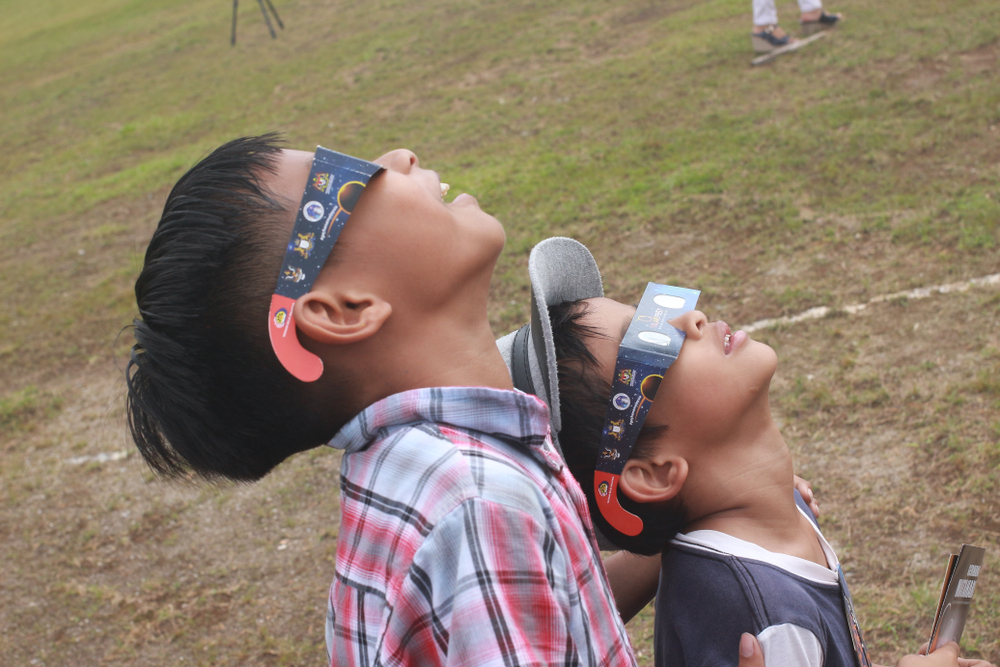
Can I make my own eclipse viewer at home?
Yes! In fact, here are instructions for making three different types of eclipse viewers at home, courtesy of ASK Magazine. Choose your favorite method and happy viewing! Alternately, you can order eclipse glasses online or pick them up from a local museum.
Option 1: The Paper Plate Method (from ASK Magazine)
Get two paper plates. Poke a small hole in one of them with a pin. You can decorate the backs if you like. With your back to the sun, let the light shine through the pinhole onto the white side of the second plate. You’ll see a small image of the sun’s disk and can watch as the moon moves over it. For a bigger image, put the second plate on the ground or have a friend hold it a few feet away.
Option 2: The Ready-Made Method (from ASK Magazine)
This option takes absolutely no crafting skills at all. Simply grab a colander, the kind with small holes. Let the sunlight shine through the colander onto the ground. You’ll see lots of little eclipse images!
Option 3: The Pinhole Camera Method (from ASK Magazine)
This is the most sophisticated homemade eclipse viewing method, but it’s still surprisingly simple. Generations of eclipse chasers have used this tried-and-true tool!
What you’ll need: a shoebox, aluminum foil, scissors, tape, a pin, and a white index card.
- Cut a square hole in one end of the shoebox.
- Tape a small square of aluminum foil over the hole.
- Stick a pin through the foil, making a tiny round hole.
- Tape or glue the index card inside the box, on the end opposite the pinhole. This is your screen.
- Cut out a small viewing hatch in the side of the box. Not too big! It should be big enough to see through, but not to let light in. Put the box lid back on.
- Point the pinhole end toward the eclipse and peek inside at the screen to watch as the sun’s circle shrinks.
Need more guidance? Use this portal to find step-by-step instructions for making an eclipse viewer, with pictures. Be sure to send us a photo of your homemade eclipse viewers so we can feature them on our social media pages!

